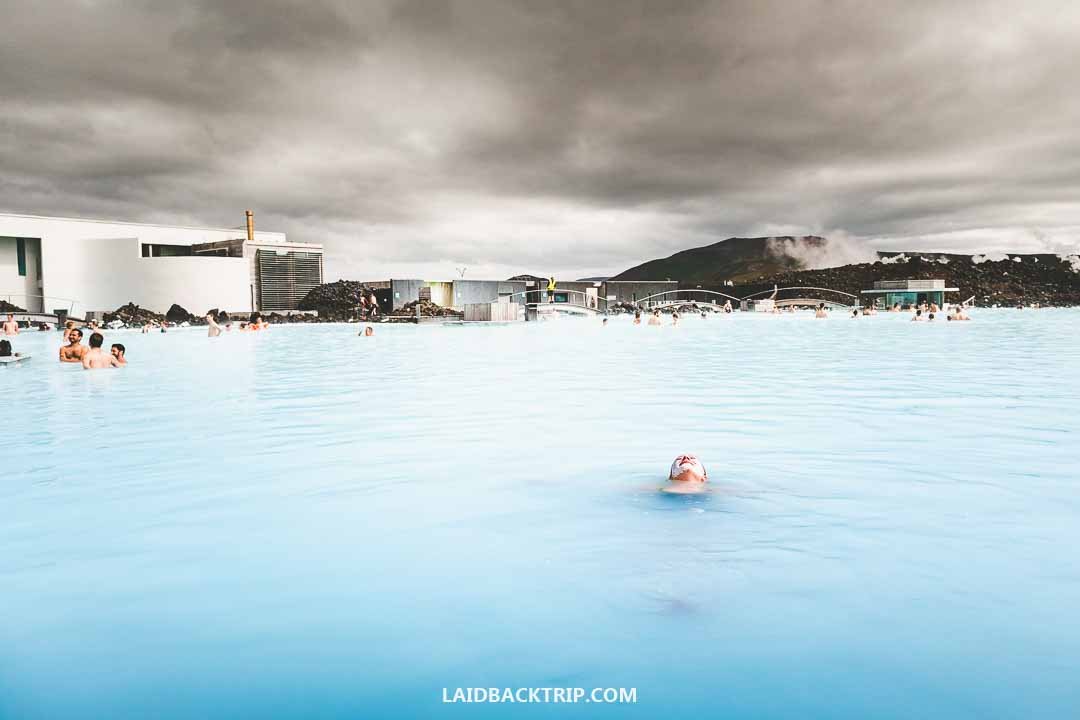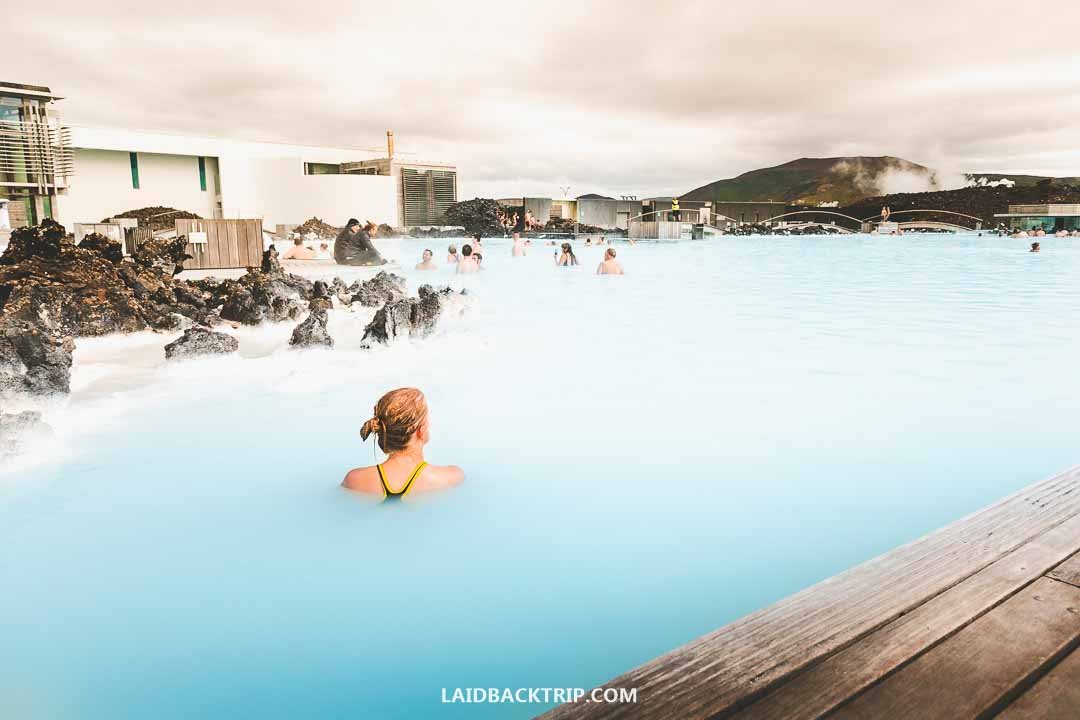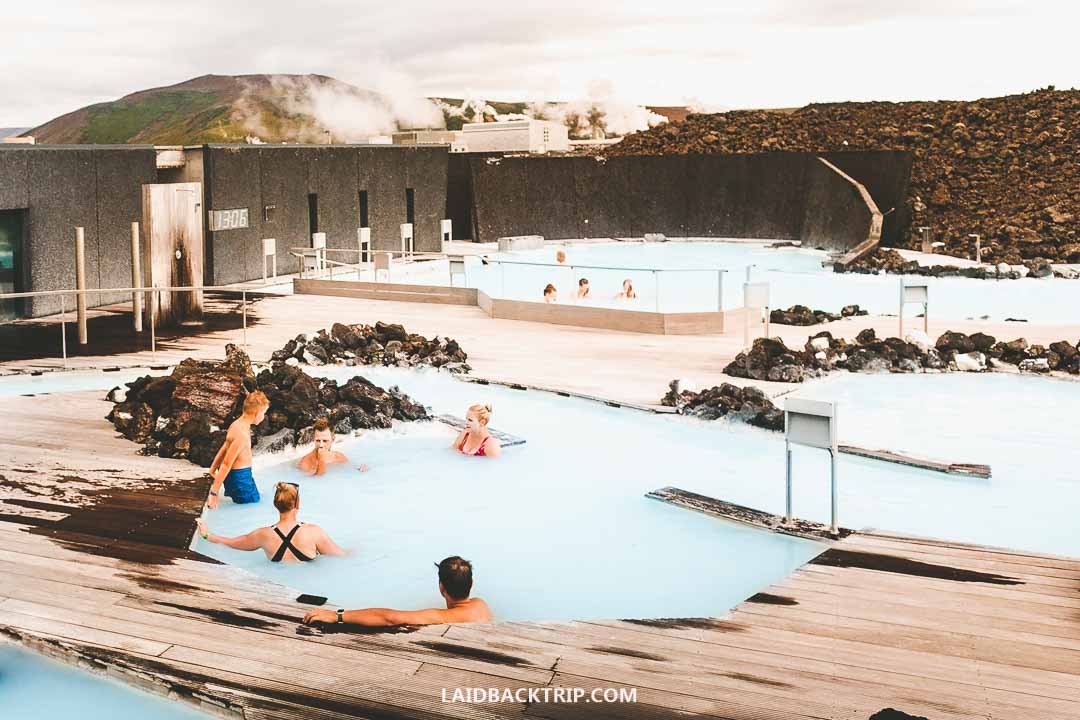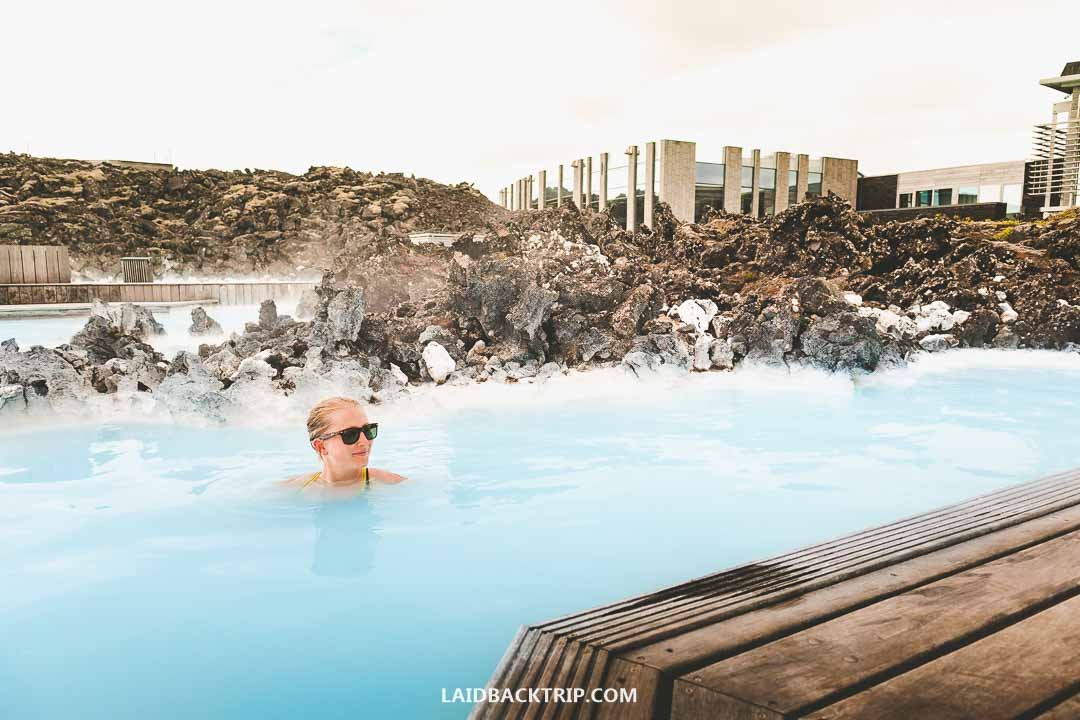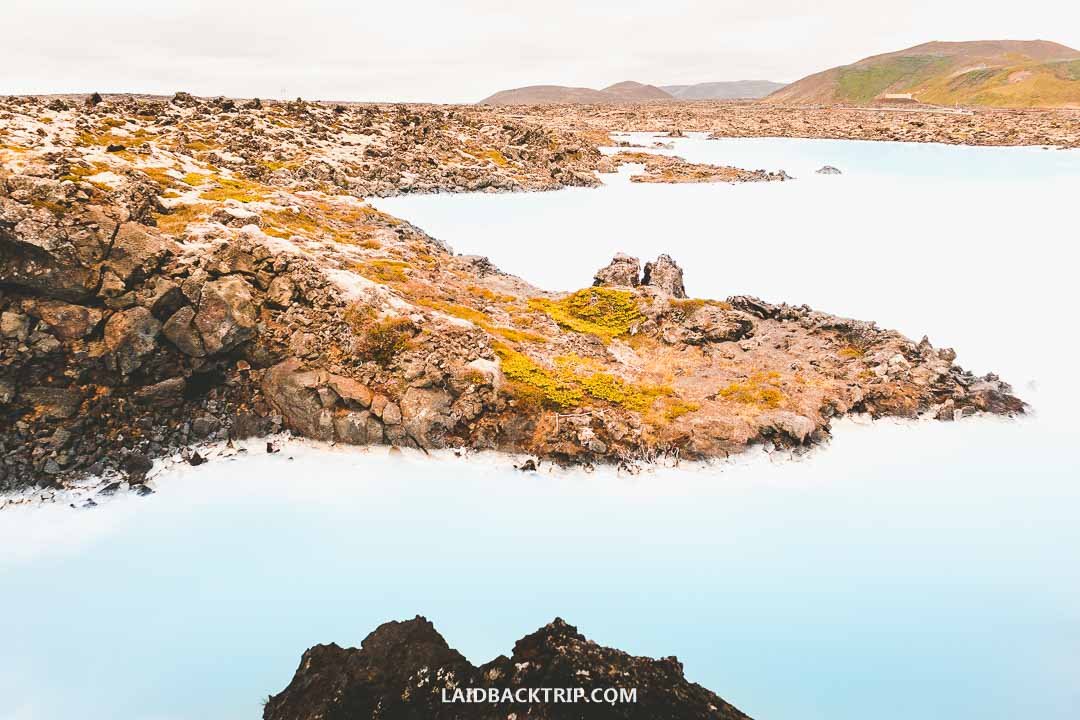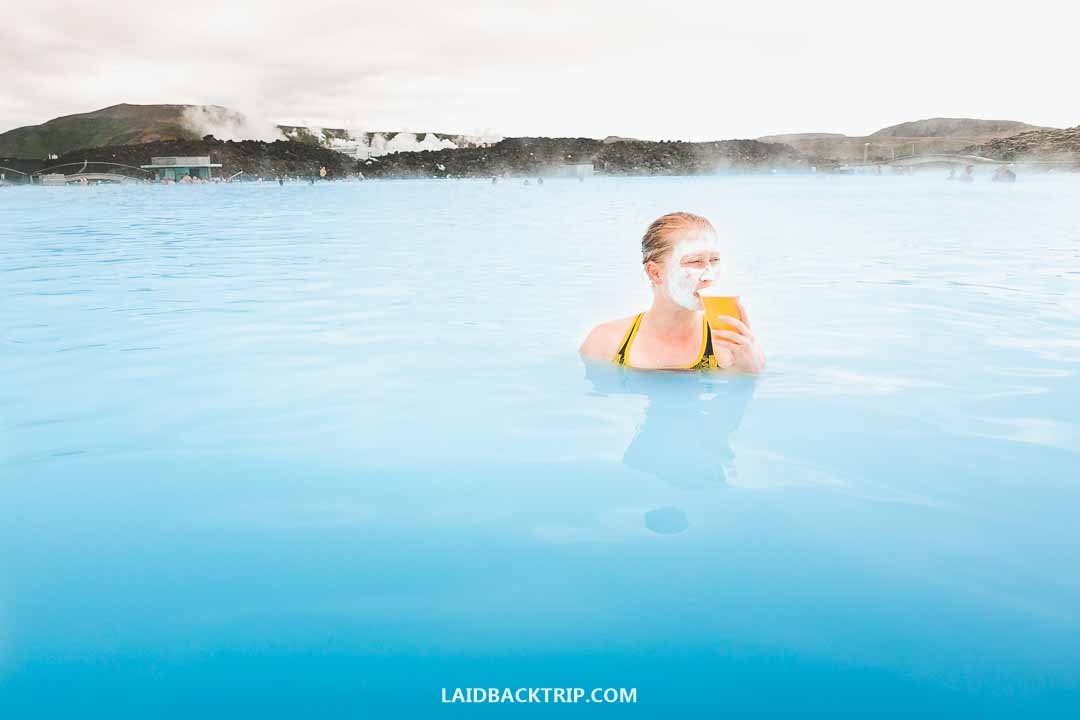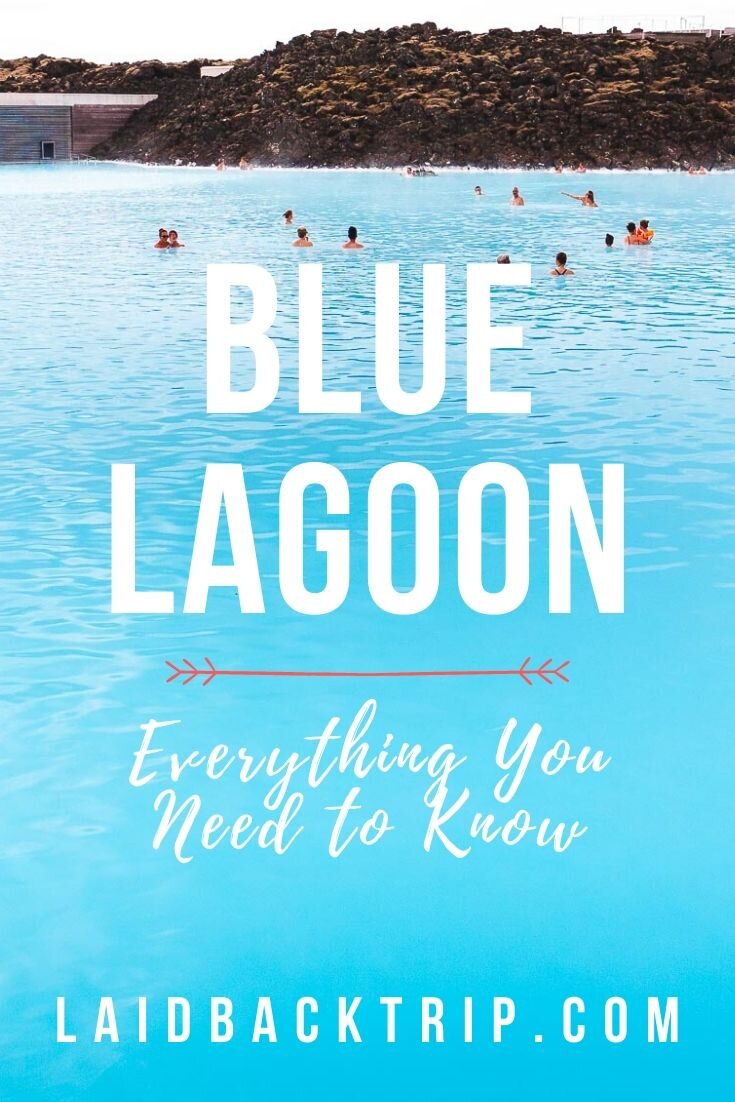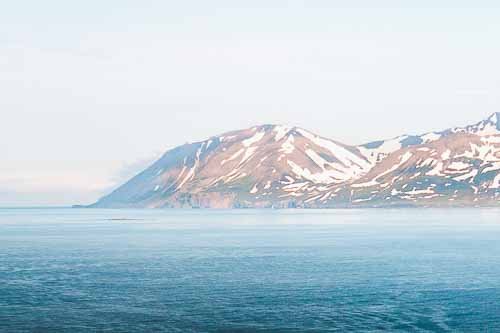A Complete Guide to Visiting the Blue Lagoon in Iceland
Our travel guide includes everything you need to know before visiting the Blue Lagoon, Iceland. Is the famous Blue Lagoon worth visiting? How much does it cost? When is the best time to take a dip? What to pack or how to get there? We've summed up all practical information for your ultimate day in this Iceland Blue Lagoon blog post.
When doing pre-trip research on the best tips and must-visit places in Iceland, it almost seems that no trip is complete without visiting the Blue Lagoon.
The Blue Lagoon Iceland images are everywhere, and it is hard to avoid discussing it with other travelers you'll meet in the country.
The milky-blue water, photogenic bridges, and renowned spa experience are reasons to put this artificial attraction on your bucket list.
To be honest, at first, we were quite reluctant to visit the Blue Lagoon.
We were not sure whether the experience was worth it for travelers like us, who do not splurge often, and first of all, who under normal circumstances get bored when sitting in the water and doing nothing in less than fifteen minutes.
On top of that, there are quite a lot of free hot pools scattered around Iceland, which are perfect for budget travelers like us, which was a fact that also made our decision process harder.
But our departure date was coming closer, and we realized that we actually did not have a plan what to do on our last day in Iceland.
Therefore, the idea of giving the Blue Lagoon a chance, and the thought, of spending the day in one of National Geographic's 25 wonders of the world slowly crept in.
At the end of the day, as travel bloggers, we are often torn as we do not want to skip such popular places.
The reason is not surprising.
We want to bring a genuine experience to you, our reader, who might be expecting us to visit attractions such as the Blue Lagoon, and use this post for planning your own Iceland itinerary.
Even though we cannot see everything, we felt that the Blue Lagoon, one of Iceland's best attractions, deserves our attention.
And we knew that later, we would have regretted it if we had not visited this amazing hot pool.
So when we were exploring Reykjanes Peninsula, we booked our ticket for a specific time slot for the next day.
From this point, there was no way back, and Martin and I were inevitably on the way to explore the famous Blue Lagoon.
Keep on reading if you are planning your visit or still hesitating whether the Blue Lagoon is worth your time and money.
In this travel guide, we share with you everything you should know before visiting the Blue Lagoon, including practical tips.
We will also answer all your burning questions such as how much the ticket costs, when to go, or where to stay while there.
So, is the Blue Lagoon overhyped tourist attraction, or is it really that great?
Let's find out.
Is Blue Lagoon Open?
Yes, Blue Lagoon and all its facilities are open despite ongoing eruptions at Sundhnukagigar (last edit: 7.6.2024).
That said, always make sure to check the most up-to-date information on the official Blue Lagoon website before you go for obvious safety reasons.
What is the Blue Lagoon
The Blue Lagoon is the most visited paid attraction in Iceland.
Well, most of the natural attractions in the country are free of charge, so we think this statement is not that relevant.
In our opinion, the Blue Lagoon would have been one of the most visited attractions in Iceland anyway.
Even though hot pools set in geothermal areas in Iceland are often natural, it is not the case with the Blue Lagoon.
What is the Blue Lagoon, then? It is a geothermal spa, and its soothing water is known for its healing powers.
If you want to see more geothermal areas in Iceland (no swimming, though), then don't forget to visit Geysir Geothermal Area and Namafjall Hverir Geothermal Area.
Why is the Blue Lagoon Blue?
So why is Blue Lagoon so famous and stands out among others? The most natural explanation is the color of the water.
The contrast of the black lava fields and steaming milky blue water is very eye-catching, and we believe it is one of the reasons why the visit is so relaxing.
Blue Lagoon attacks all your senses.
One of the most common questions is why is the Blue Lagoon blue.
When you examine the water of the lagoon closely, you will find out that it is rather white than blue.
So what is the trick? And is the Blue Lagoons' water naturally really that blue?
The answer and the myth behind this hot pool are quite straightforward.
The Blue Lagoon is rich in silica, which is the most abundant element, and silica reflects visible light while other colors are absorbed.
That's why the color is bluer when the weather is nice and sunny.
History of the Blue Lagoon
Before visiting the Blue Lagoon, we knew very little about the place and its history.
Had we read a few articles, we would not have been that surprised by seeing a geothermal power plant right next to the pool. Yes, you hear it right.
In fact, the creation of Blue Lagoon was an unintentional side effect of runoff water from Svartsengi Power Plant (1971) - it is the power plant you can see today next to the world's renowned spa.
Iceland is known for utilizing geothermal energy for almost everything, as it would be a shame not to use this valuable resource coming out off the ground.
Svartsengi Power Plant drills deep in the earth to get access to the hot water.
It has a small flaw, though. The water contains minerals, plus it is mixed with seawater.
Therefore, this drilled water cannot be used, but people found a solution - this water heats freshwater, and this super-hot water warmed up by saltwater then generates electricity.
Once the water is used, it is released to the lava field that surrounds the power plant as there is no other use for it.
And this is basically how the first pools around the power plant appeared.
It did not take long, and people started noticing the side effect of the plant, and one desperate man who wanted to treat his psoriasis (skin disease), decided to take a bath.
His condition improved, and from this point, the Blue Lagoon started to be a sought-after attraction back then by locals only.
The first bathing facilities at Blue Lagoon opened in 1987.
And even though a lot has changed since then, for example, the whole complex was modernized, and it was even moved a bit further from the power plant, one important thing remained.
The healing waters rich in silica.
Sure, people can object that the Blue Lagoon is far from its original idea when people from Reykjavik and its surroundings were coming to enjoy natural baths in lava fields, and they are not wrong.
Thanks to the fact that the number of visitors to Iceland has been growing dramatically in the past years, the concept had to change.
On average, around 4000 people visit the Blue Lagoon daily during the high season, so the changes were necessary.
But what we could see, the Blue Lagoon was delicately rebuilt to satisfy the needs of its visitors, while it still provides everyone with the main reason people came for.
The milky blue water and relaxing atmosphere.
Blue Lagoon Facts
Do you want to know learn more about the Blue Lagoon?
Except for what we've already mentioned, that the lagoon is artificial, here are some interesting facts.
The water temperature fluctuates a bit, depending on where you stand. In general, the water temperature in Blue Lagoon is between 37°C to 40°C.
Before the Blue Lagoon, we visited the natural Reykjadalur Hot Springs Rive.
And we must say that the temperature here in the Blue Lagoon was more pleasant as the natural river was hotter than we expected (no complaints, though).
The water is rich in minerals, especially silica, salt, and algae - you can put on a mask including those minerals.
The Blue Lagoon was featured in many commercials and marketing spots.
The maximum depth of the Blue Lagoon is 1.6 meters.
Therefore, kids must be accompanied all the time, and they must use floaters (you can rent them at the desk).
Entrance Fee
What was the main reason that discouraged us from visiting the Blue Lagoon at the beginning?
It was the price. Yes, visiting Blue Lagoon is a quite expensive activity.
We know that travelers who like pampering and visiting spas around the world are probably used to paying for this kind of service at similar prices, but the cost of the visit seemed to us quite high at first.
The Blue Lagoon ticket price is dynamic, as it changes depending on the date and time of the day.
So how much does it cost to visit the Blue Lagoon?
Generally, the Blue Lagoon entrance fee is between 42 USD and 171 USD.
As you can see, the best you can do is check out the time slots every now and then, as the difference is quite big.
Tickets
There are three types of tickets to choose from, and it is only up to you what kind of service you require and what is your Iceland budget.
Unsurprisingly, we opted for the cheapest ticket.
Still, it included everything we needed, and when we were leaving the Blue Lagoon, we had a feeling that the quality and service we received for our money was adequate.
It is good to know that you must reserve your ticket in advance for an exact date and exact time.
You can stay in the lagoon as long as you want, but when you book your visit, for example, for 9 AM, you must show up between 9 AM and 10 AM.
We do not recommend entering the facility without a reservation.
First of all, your desired time slot might not be available, and your experience won't be that smooth from the very beginning.
Here is the list of the three ticket options you have - choose the one that suits your needs best.
Comfort Ticket
Blue Lagoon Comfort Ticket is the most basic one, but according to our experience, it offers more than enough.
What is included? Entrance to the Blue Lagoon, silica mud mask, towel, and a free drink.
The starting price was 42 USD, but on the day of our visit, the price was already 49 USD.
The price probably increases when the demand is higher for a particular time slot.
We really enjoyed one drink that was included in our entrance fee.
Otherwise, alcohol in Iceland is very expensive, and you will pay 10 USD per beer minimum.
You might be wondering how you will pay for the refreshment in case you want another one.
You will get an electronic bracelet with a chip at the entrance, which you can tie around your wrist.
Then everything you purchase is loaded on it, and you will pay at the exit before you leave.
It is also good to know that it is allowed to purchase a maximum of three alcoholic drinks per visit because of safety and hygienic reasons.
Here you can purchase Blue Lagoon Comfort Ticket in advance.
Premium Ticket
Premium ticket includes everything that Comfort ticket does, but on top of that, you can enjoy the second mask.
You will also get slippers, a bathrobe, a table reservation at Lava Restaurant, and a glass of sparkling wine in Lava Restaurant, but only in case, you are going to dine there.
We do not think that slippers and bathrobes are worth paying an additional twenty plus dollars.
Therefore, we would have opted for this choice only in case you plan on dining in the restaurant.
Here, you can purchase your Blue Lagoon Premium Ticket with Transfer in advance.
The Retreat Spa
As the name suggests, this is the best ticket you can get in the Blue Lagoon, which ensures your visit will be truly luxurious.
If you have the cash to spend, celebrate a special occasion, or saved enough money for a once-in-a-lifetime experience, this is the option for you.
The ticket includes five hours of exclusive entry to Retreat Spa, Blue Lagoon, a private changing room, the Blue Lagoon Ritual, skincare amenities, and a drink of your choice.
Choosing the ticket really depends on your Iceland budget and travel style, and there is no pressure to upgrade the ticket if you don't want to.
Opening Hours
Blue Lagoon is open from 9 AM to 9 PM from January to May.
In June, it's open from 8 AM to 10 PM.
The opening hours from July to August are 8 AM to 11 PM.
In September, from 8 AM to 10 PM.
And lastly, it's open from 8 AM to 11 PM from October to December.
Keep in mind that you should leave the lagoon 30 minutes before it closes.
And don't forget that the Blue Lagoon can be closed for a few days every year due to maintenance, usually in the off-season.
When is the Best Time to Visit the Blue Lagoon
The Blue Lagoon is open year-round, and no kind of weather should stop you from visiting the site, as we believe the place is magnificent even when it rains and hails.
Iceland sees most travelers in the summer, between June and August, so be prepared for lines near the entrance and slightly crowded facilities during these months.
On the other hand, the possibility of prebooking and limited time slots are here to prevent the lagoon from being crowded beyond its limits.
Here you can find the best time to visit Iceland.
Blue Lagoon in Summer
What is the only difference between visiting the Blue Lagoon in summer and winter?
Summer guarantees long days and slightly higher temperatures, and you have a better chance to enjoy sunny weather (but the weather in Iceland is a chapter on its own).
Blue Lagoon in Winter
The only downside of visiting in the winter is the bigger difference between water temperature and air temperature.
You will feel a bit uncomfortable outside the lagoon, but the water temperature will sit between 37 and 40 degrees, the same as during the rest of the year, and we do not expect you to walk around the lagoon anyways.
In winter, you have a unique chance to observe Nothern Lights from the Lagoon when lucky, which must be awesome.
Time of the Day
When it comes to the time of the day, the best time to avoid the procession of visitors is right when the Blue Lagoon opens, around 8 AM.
If you get up early, you might even be the first person in the lagoon that day!
During the day, the Blue Lagoon fills up, and the busiest times are between 11 AM and 3 PM.
Visiting the Blue Lagoon later in the evening is not a bad idea either. The only downside is that you won't have that much time for your relaxation because of the closing time.
Having said that, we arrived in the Blue Lagoon around noon and did not have a feeling that there were that many people.
As there is a small screen displaying the layout of lockers at the entrance, 52% of men's lockers were occupied on that day, to be precise.
The area is large, and people usually disperse.
How Much Time Do You Need for Visiting the Blue Lagoon
On average, we would say that it is absolutely enough to allow yourself two hours for the Blue Lagoon.
However, the time every traveler needs for visiting the Blue Lagoon is highly individual.
In two hours, you'll have enough time to explore every nook of the lagoon, use the sauna and steam room, have a beer, and relax for a while.
We spent in the lagoon a bit more than three hours, but it was mostly because we were waiting for our late evening flight and had nothing better to do.
If you've purchased your Luxury ticket or Premium with dining in the restaurant, you will, of course, need at least half of the day to enjoy all the perks.
But even without upgraded tickets, we know that people are able to spend in the lagoon a whole day - that's why how much time you need to allocate really depends on your preferences.
How to Get to the Blue Lagoon
Blue Lagoon is located near Grindavík, a small town on Reykjanes Peninsula. Yes, you hear it right.
The Blue Lagoon is outside the capital city of Iceland, Reykjavik, although it is not far.
The Blue Lagoon is within driving distance from Reykjavik or Keflavik International Airport.
Therefore, many travelers visit the Blue Lagoon either right after they arrive in Iceland, or it is their last activity before dropping the car off at the airport.
We also planned the visit to Blue Lagoon for our last day, but our Go Campers rental office was in Hafnarfjordur.
So from the lagoon, we drove there, dropped off the car, and then we took a bus to Reykjavik, where we spent the rest of the day.
So how do you get to the Blue Lagoon?
Car
The easiest way how to get to the Blue Lagoon is by your rental car or campervan.
You can get there either from Keflavik Airport, Reykjavik, or any other location on your itinerary.
Blue Lagoon is 24 kilometers southeast of Keflavik Airport and 50 kilometers southwest of Reykjavik.
Finding the Blue Lagoon is easy.
Simply enter Blue Lagoon in your GPS and then follow the instructions.
If you are used to following the road signs, look for Bláa Lónið, which is the Blue Lagoon in the Icelandic language.
Parking
There is a large free parking at Blue Lagoon right in front of the entrance.
Shuttle
A shuttle bus runs between Reykjavik and the Blue Lagoon all day, which is very convenient.
You might be interested in whether there is a shuttle between Keflavik Airport and Blue Lagoon, but it seems that there is not this kind of service anymore.
I even called the Blue Lagoon hotline, and they told me that their official bus also runs only between their facility and Reykjavik.
Here, you can reserve a Blue Lagoon Return Transfer that runs every hour.
Public Transport
Unfortunately, at the moment, there is no public transport between Reykjavik or Keflavik and the Blue Lagoon.
Even though there is a bus to Grindavik, the Blue Lagoon is still eight kilometers from there.
Therefore, it is not convenient, and taking a cab from the settlement would cost you quite a lot too.
Taxi
In case you do not have your car and taking a shuttle is not the right option for you, there is always the possibility to take a cab.
Taxis are quite expensive in Iceland (like everything).
On the other hand, this transport is a hassle-free alternative that does not require much planning.
This Private Blue Lagoon Transfer will take you from Keflavik Airport or Reykjavik to the Blue Lagoon or vice versa.
Tours
The Blue Lagoon is one of the most popular things to see and do in the area.
It is quite natural that many tour companies have incorporated it into their itineraries.
There are three popular options right now, Reykjanes Peninsula, Fagradalsfjall Volcano, and the Golden Circle, all of them including Blue Lagoon.
Here you can book a Golden Circle Tour that includes the entrance ticket to the Blue Lagoon as well.
This Fagradalsfjall Volcano Hike and Blue Lagoon is also very popular.
The lagoon is on Reykjanes Peninsula, so it only makes sense to explore this area a bit more thoroughly.
Here you can take a Reykjanes Geopark Tour that includes Blue Lagoon.
What to Pack for the Blue Lagoon
You do not have to pack many things for visiting the Blue Lagoon.
A towel is included in the ticket; the same as shampoo, soap, and conditioner are provided in the shower.
So the only essential thing you should not forget is a swimsuit.
Lockers are reasonably large (there are also bigger lockers in case you have extra-size luggage for a fee), so you can fit there all your clothes, backpack, and valuables.
It is a good idea to buy a waterproof case for your phone, in case you plan on taking photos, just in case.
If the Blue Lagoon is the last place to tick off from your itinerary, take with you a dry sack, where you can later store your wet swimsuit before the flight.
Also, do not forget to apply sunscreen on your face and upper body.
Flip-flops are not necessary, and in case you booked the upgraded ticket, slippers are included.
Also, if you are looking for some packing tips, read our guide on what to pack for Iceland.
Tips for Visiting the Blue Lagoon
Here are some additional things every visitor should know about Blue Lagoon.
Photography
You can take photos in the Blue Lagoon. For obvious reasons, photography is not allowed in the changing rooms and showers.
Take a Shower
When we were reading things to know before visiting the Blue Lagoon, many people seemed to be disgruntled by the fact that every visitor to any spa in Iceland must shower naked before entering the lagoon.
Well, to be honest, we do not know where the problem is.
We do the same in the Czech Republic in every public swimming pool. It is not enforced by law, though. It’s just common sense.
In Iceland, when entering pools without showering, you basically break the law. And we are actually glad they are so strict about the pool ethics and hygiene.
How to Protect Your Hair
One of the big themes when visiting the Blue Lagoon is how to avoid damaging your hair.
The water is rich in silica, and it is recommended to cover your hair in a hair conditioner (it is available in the shower, together with shampoo and soap).
When you have long hair, you should twist it up and, if possible, keep it away from water entirely.
Martin and I did not take it that seriously.
We used the conditioner, but we both inadvertently dipped our hair during our visit.
Yes, later, even when I rinsed my hair, it was a weird feeling.
I also took a shower right after we arrived in Prague (we visited the lagoon on our very last day in Iceland), and it was normal again.
I must premise that I am not crazy about my hair. I do not color it and go to a hairdresser like once a year.
Still, I would not be worried that Blue Lagoon water would cause you any serious damage to most visitors.
The easiest way to protect your hair in Blue Lagoon is to cover your hair in a conditioner, avoid dipping your head into the water and swim more carefully.
Or just buy a swim cap.
Contact Lenses and Dioptric Glasses
When we were checking-in in the spa, the receptionist told us to take off contact lenses and do not even go inside with our dioptric glasses.
When we told her that we were both short-sighted without it, she told us to be careful and make sure the water did not get in our eyes.
If you have the same problem with your eyes as we do, no worries.
If you are careful, nothing will happen. I wore my sunglasses to prevent splashes, and everything was fine.
Jewelry
It is important to know that you should keep all your jewelry in the locker as the water may cause serious damage to it.
How to Visit the Blue Lagoon: Our Step by Step Experience
Visiting unfamiliar and modern facilities can sometimes be confusing.
With our step-by-step guide, you will exactly know what to expect from the Blue Lagoon experience, from the very first moment until the end.
Arrival
We parked our campervan on the designated parking lot and followed the signs to the Blue Lagoon entrance, leading through the lava field.
Check-in
Once we were inside, we could see two lines. One line was for Comfort ticket holders, while the second one was for those who bought an upgraded ticket.
We waited in the queue for less than ten minutes, and then we were greeted by a friendly receptionist.
She scanned our ticket (it is enough to have an online version on your mobile phone), gave us a wristband that serves as a key for lockers and as a medium to pay for drinks, and she navigated us to changing rooms.
Changing Rooms
Ladies' changing room was on the ground floor, while men's was on the upper floor.
The changing room is very modern, and the only thing you must do is to find and open the available locker.
Put all your clothes and valuables inside, shut it, and lock it with your wristband at the nearest scanner.
And then only remember the number of your locker. Easy peasy. In the worst case, there is always someone from the staff who can help you with it.
Showers
Then continue to the showers (without swimsuit), dress your swimsuit after a shower, and then you can finally get to the Blue Lagoon.
Clean towels are by the entrance to the lagoon, but we took them later on the way back to the showers.
Blue Lagoon
From now on, it is only up to you how you will spend your time.
After entering the wonderfully blue water and walking around a bit to get an idea of what it looked like, we headed to the left to apply a mask that was included in our ticket.
Then Martin went to a locker room to grab a camera to take some photos while I was enjoying the hot water.
After he took a few pictures, he joined me, and we went to the right side of the lagoon to the bar.
With a drink in hand, we carefully crossed the lagoon and found seats in the least crowded part of the lagoon.
The rest of the day in the Blue Lagoon was the mixture of sitting in the warm water, walking slowly around, and enjoying the sauna and steam room.
As we were in Myvatn Baths as well, we must say that sauna here in the Blue Lagoon was quite a disappointment.
Do not take us wrong, the room itself was great.
The only problem was that it was Saturday, and on that day there were many families with kids, and they were all the time entering the sauna and steam room, so there was no chance to warm it up and relax.
After approximately three hours, we were ready to leave.
We grabbed a towel and went to the showers, where we carefully rinsed silica and other minerals off our bodies, dressed again, and waited for each other by the exit.
Check-out
Here we gave the wristband to a receptionist, she scanned it to find out if we purchased something, and we were ready to go.
Travel Insurance
We never leave home without travel insurance that was designed to cover our expenses if something goes wrong during the trip.
Travel insurance protects against theft, flight delays, injury, illness, cancellations, and much more.
World Nomads provides travel insurance for travelers to cover their trip essentials, including sports and adventure activities.
SafetyWing is affordable travel insurance for backpackers, long-term travelers, and digital nomads.
Travel smarter and safer!
Services
Except for floating in the warm and healing waters, it is possible in the Blue Lagoon to dine, take a massage, or shop.
Restaurants
Even though we would recommend you bring a snack after seeing the prices, you can choose from four restaurants.
Cafe, where you can buy a snack and refreshment.
Then there is Spa Restaurant which is available for those who purchased the most expensive ticket.
Lava Restaurant that offers fantastic views over the Blue Lagoon, and you can dine here in your bathrobes until a certain time in the afternoon.
Last but not least, there is Moss Restaurant, which is a pride of the resort as it is recommended by Michelin Guide.
Free Drinking Water
When you are thirsty, and you have already used up your one free drink, there is a free water fountain under one of the bridges in the lagoon, where you can drink for free!
Massages and Treatments
If you love pampering yourself, book either an in-water massage, regular massage, or beauty treatments.
This service costs extra, and it is highly recommended to make a reservation.
Souvenirs
If you are looking for an original gift from Iceland, or you simply like quality cosmetics, you can buy products from the bioactive elements of geothermal seawater.
The shop is either on-site, but you will find one at the airport and then in the center of Reykjavik.
Where to Stay
As we've already mentioned, Blue Lagoon is located in Grindavik, a small town on Reykjanes Peninsula, but most of the people visit it either from Reykjavik or Keflavik Airport.
So, where is the best place to stay before or after visiting the Blue Lagoon? What is the best hotel near the Blue Lagoon?
Everything here depends on your budget as the selection is quite large, especially in Reykjavik.
Grindavik offers quite reasonably priced hotels, Hafnarfjordur, which is on the way to Reykjavik, also has hotels for every type of traveler, and there is one hotel super-close to the airport.
And then there are two hotels that belong to the Blue Lagoon that offer superb services, and the location for visiting the lagoon and enjoying the atmosphere possibly could not be better.
We've handpicked the best hotels in every location you can consider for your Blue Lagoon visit.
Blue Lagoon | The Retreat at Blue Lagoon Iceland - Even though there are two hotels near the lagoon (the other one is called Silica Hotel), The Retreat is the shining star here. If you want to spend a night in a hotel set in a unique landscape, this is the place. Just be prepared that your wallet might cry.
Grindavik | Guesthouse Borg - Simple but clean guesthouse offers everything a traveler needs, very close to the Blue Lagoon, for a fair price.
Keflavik Airport | Airport Hotel Aurora Star - Conveniently located within walking distance from the airport, this modernly decorated hotel is a perfect choice in case you arrive early in the morning or wait for a late flight.
Hafnarfjordur | Hotel Viking - Flybus stops in front of this hotel, so it is for many travelers choice number one in the town.
Reykjavik | Midgardur by Center Hotels - Close to all top attractions, this hotel offers its guests amazing services. Except for comfortable beds and a tasty breakfast, you can relax in an on-site spa.
Is the Blue Lagoon Worth Visiting?
Even though we were quite worried that we might not enjoy our time in the Blue Lagoon as we are not exactly spa people, we really liked it.
Indeed, we do not have many similar experiences to compare with, but overall we found the price we paid for the entrance and the services we received in return, fair.
No matter whether you are after a long flight, you need to kill some time before coming back home, or you are longing to visit the Blue Lagoon just for the spa experience and relaxation, we are pretty confident you are going to enjoy it.
Hopefully, our Blue Lagoon guide helped you with planning your visit, and you found out everything you needed to know before traveling to the Blue Lagoon.
Travel Resources
Here you can find links to all the travel resources we use and which you might find helpful when planning your next holiday.
Accommodation: When looking for accommodation, we usually search hotels via Booking.com or Hostelworld.
Tours: Although we love to travel independently, some places are better to visit with a guided tour.
We prefer GetYourGuide for its easy-to-use interface and solid reputation. Another great alternative is Viator.
Rental Cars: When going on a road trip, we always use Rentalcars.com, a reliable site for booking a rental car in advance.
Flight Tickets: When looking for flight tickets, you can search Skyscanner to find the best price.
Travel Insurance: World Nomads and SafetyWing cover against risks of travel.

